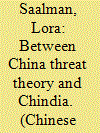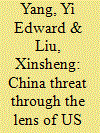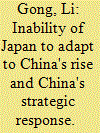| Srl | Item |
| 1 |
ID:
103980


|
|
|
| 2 |
ID:
112835


|
|
|
|
|
| Publication |
2012.
|
| Summary/Abstract |
China scholars have examined the 'China threat' theory from various theoretical perspectives, offered a range of explanations for the theory's emergence and forecast the potential implications for US-China relations. However, few scholars have empirically studied the 'China threat' theory through the lens of the US media. This is a critical oversight, because the media plays a pivotal role in shaping US public opinion and US foreign policy, and the media is a key channel for 'China threat' dissemination and popularization. This study seeks to redress this oversight by empirically examining 'China threat' coverage in the US print media over a 15-year period from 1992 to 2006. We use content-analysis methodology to systematically collect, code and analyze 'China threat' data from five major US newspapers and to track the frequency and content of this coverage over time.
Our analysis reveals many interesting patterns in 'China threat' media coverage. First, the initial emergence of 'China threat' arguments in the US print media corresponded with the sharp upward turn in China's economic growth rates in the early 1990s. However, since the early 1990s, 'China threat' coverage has not mirrored China's steady growth. Rather, the media coverage was cyclic, featuring three key peaks (1996, 2000 and 2005) followed by subsequent declining interest. Second, our analysis reveals that the focus of these stories also varied over time. Perceptions of China as a political/ideological threat dominated media coverage in the earlier years (1992-1994) but steadily declined after 1995 and totally disappeared from the US print media after 2001. Perceptions of China as a military/strategic threat replaced political/ideological concerns in 1995, and the military focus has dominated media coverage ever since. Perceptions of China as an economic/trade threat persisted steadily throughout the 15-year time period with a clear uptick in recent years. We conclude this analysis by turning to the literature on realism, agenda setting and information processing to offer possible explanations for these empirical trends.
|
|
|
|
|
|
|
|
|
|
|
|
|
|
|
|
| 3 |
ID:
129900


|
|
|
|
|
| Publication |
2014.
|
| Summary/Abstract |
For rationalists, China (PRC)'s current conciliatory policy toward Taiwan is merely "calculative." Hence, Chinese leaders must act patiently with Taiwan to dampen the "China threat theory." This article contends that strategic considerations cannot entirely justify Beijing's Taiwan policy. Given the PRC's steadfast position on reunification, it is unclear why Beijing has, since the 1990s, allowed for a looser construction of the "one China" principle and even tacitly acknowledged the existence of Taiwan's Republic of China (ROC). In line with the constructivist theory of argumentative persuasion, my position stresses that changing discourses have affected Chinese leaders' perceptions of the Taiwan Strait problem. New identities and interests have been reconstituted to redefine the PRC relations vis-à-vis the ROC. While it is unlikely that Beijing would formally accept the ROC, the current trajectory raises hope that cross-strait ties may become more stabilized in the long run.
|
|
|
|
|
|
|
|
|
|
|
|
|
|
|
|
| 4 |
ID:
130624


|
|
|
| 5 |
ID:
089835


|
|
|
|
|
| Publication |
2009.
|
| Summary/Abstract |
The United States is the most developed country in the world and the number one energy-importing country. China is the largest developing country and the number two energy-importing country. The energy issue is thus a key issue in Sino-US Relations. The United States has been on bad terms with some energy-rich "problem countries", while the energy cooperation between China and these countries is starting to go well. Sino-US relations now affect the whole world, and China's and the United States relations with these key energy producers-the third party factor may become a major source of competition and conflict between the two powers.
|
|
|
|
|
|
|
|
|
|
|
|
|
|
|
|